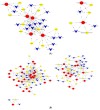Integrated Analysis of the ceRNA Network and M-7474 Function in Testosterone-Mediated Fat Deposition in Pigs
- PMID: 35456474
- PMCID: PMC9032878
- DOI: 10.3390/genes13040668
Integrated Analysis of the ceRNA Network and M-7474 Function in Testosterone-Mediated Fat Deposition in Pigs
Abstract
Castration can significantly enhance fat deposition in pigs, and the molecular mechanism of fat deposition caused by castration and its influence on fat deposition in different parts of pigs remain unclear. RNA-seq was performed on adipose tissue from different parts of castrated and intact Yorkshire pigs. Different ceRNA networks were constructed for different fat parts. GO and KEGG pathway annotations suggested that testosterone elevates cell migration and affects differentiation and apoptosis in back fat, while it predisposes animals to glycolipid metabolism disorders and increases the expression of inflammatory cytokines in abdominal fat. The interaction between M-7474, novel_miR_243 and SGK1 was verified by dual fluorescence experiments. This ceRNA relationship has also been demonstrated in porcine preadipocytes. Overexpression of M-7474 significantly inhibited the differentiation of preadipocytes compared to the control group. When 100 nM testosterone was added during preadipocyte differentiation, the expression of M-7474 was increased, and preadipocyte differentiation was significantly inhibited. Testosterone can affect preadipocyte differentiation by upregulating the expression of M-7474, sponging novel-miR-243, and regulating the expression of genes such as SGK1. At the same time, HSD11B1 and SLC2A4 may also be regulated by the corresponding lncRNA and miRNA, which ultimately affects glucose uptake by adipocytes and leads to obesity.
Keywords: castration; ceRNA; fat deposition; lncRNA; testosterone.
Conflict of interest statement
The authors declare no conflict of interest.
Figures








Similar articles
-
Sus_circPAPPA2 Regulates Fat Deposition in Castrated Pigs through the miR-2366/GK Pathway.Biomolecules. 2022 May 26;12(6):753. doi: 10.3390/biom12060753. Biomolecules. 2022. PMID: 35740877 Free PMC article.
-
LncRNA IMFlnc1 promotes porcine intramuscular adipocyte adipogenesis by sponging miR-199a-5p to up-regulate CAV-1.BMC Mol Cell Biol. 2020 Nov 4;21(1):77. doi: 10.1186/s12860-020-00324-8. BMC Mol Cell Biol. 2020. PMID: 33148167 Free PMC article.
-
Identification of Long Non-Coding RNA-Associated Competing Endogenous RNA Network in the Differentiation of Chicken Preadipocytes.Genes (Basel). 2019 Oct 12;10(10):795. doi: 10.3390/genes10100795. Genes (Basel). 2019. PMID: 31614854 Free PMC article.
-
Identification and characterization of long non-coding RNAs in subcutaneous adipose tissue from castrated and intact full-sib pair Huainan male pigs.BMC Genomics. 2017 Jul 19;18(1):542. doi: 10.1186/s12864-017-3907-z. BMC Genomics. 2017. PMID: 28724410 Free PMC article.
-
A comprehensive microRNA expression profile of the backfat tissue from castrated and intact full-sib pair male pigs.BMC Genomics. 2014 Jan 20;15:47. doi: 10.1186/1471-2164-15-47. BMC Genomics. 2014. PMID: 24443800 Free PMC article.
Cited by
-
Meta-analysis of RNA-Seq datasets highlights novel genes/pathways involved in fat deposition in fat-tail of sheep.Front Vet Sci. 2023 May 12;10:1159921. doi: 10.3389/fvets.2023.1159921. eCollection 2023. Front Vet Sci. 2023. PMID: 37252399 Free PMC article.
-
Deciphering the role of alternative splicing as a potential regulator in fat-tail development of sheep: a comprehensive RNA-seq based study.Sci Rep. 2024 Jan 29;14(1):2361. doi: 10.1038/s41598-024-52855-1. Sci Rep. 2024. PMID: 38287039 Free PMC article. Review.
-
Testosterone Inhibits Lipid Accumulation in Porcine Preadipocytes by Regulating ELOVL3.Animals (Basel). 2024 Jul 23;14(15):2143. doi: 10.3390/ani14152143. Animals (Basel). 2024. PMID: 39123669 Free PMC article.
References
-
- Robison O.W., Johnson B., Lubritz D. Genetic parameters for testosterone production in boars. J. Anim. Sci. 1991;69:3220–3224. - PubMed
-
- Yeh S., Tsai M.Y., Xu Q., Mu X.M., Lardy H., Huang K.E., Lin H., Yeh S.D., Altuwaijri S., Zhou X., et al. Generation and characterization of androgen receptor knockout (ARKO) mice: An in vivo model for the study of androgen functions in selective tissues. Proc. Natl. Acad. Sci. USA. 2002;99:13498–13503. doi: 10.1073/pnas.212474399. - DOI - PMC - PubMed
Publication types
MeSH terms
Substances
LinkOut - more resources
Full Text Sources

